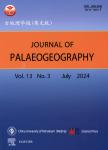Submarine fans: A critical retrospective (1950-2015)
Submarine fans: A critical retrospective(1950-2015)作者机构:Department of Earth and Environmental Sciences The University of Texas at Arlington Arlington TX 76019 USA
出 版 物:《Journal of Palaeogeography》 (古地理学报(英文版))
年 卷 期:2016年第5卷第2期
页 面:110-184页
核心收录:
学科分类:0303[法学-社会学] 0710[理学-生物学] 070704[理学-海洋地质] 0709[理学-地质学] 07[理学] 0707[理学-海洋科学] 0708[理学-地球物理学] 0705[理学-地理学] 0815[工学-水利工程] 0813[工学-建筑学] 0833[工学-城乡规划学]
主 题:The Bouma Sequence High density turbidity currents Sandy debris flows Turbidite facies models Submarine fans Submarine canyons Submarine channels Submarine lobes Lowstand systems tract
摘 要:When we look back the contributions on submarine fans during the past 65 years (1950 -2015), the empirical data on 21 modern submarine fans and I0 ancient deep-water sys- tems, published by the results of the First COMFAN (Committee on FANs) Meeting (Bouma eta|., 1985a), have remained the single most significant compilation of data on submarine fans. The 1970s were the "heyday" of submarine fan models. In the 21st century, the general focus has shifted from submarine fans to submarine mass movements, internal waves and tides, and contourites. The purpose of this review is to illustrate the complexity of issues surrounding the origin and classification of submarine fans. The principal ele- ments of submarine fans, composed of canyons, channels, and lobes, are discussed using nine modern case studies from the Mediterranean Sea, the Equatorial Atlantic, the Gulf of Mexico, the North Pacific, the NE Indian Ocean (Bay of Bengal), and the East Sea (Korea). The Annot Sandstone (Eocene-Oligocene), exposed at Peira-Cava area, SE France, which served as the type locality for the "Bouma Sequence", was reexamined. The field details are documented in questioning the validity of the model, which was the basis for the turbidite- fan link. The 29 fan-related models that are of conceptual significance, developed during the period 1970-2015, are discussed using modem and ancient systems. They are: (I) the classic submarine fan model with attached lobes, (2) the detached-lobe model, (3) the channel-levee complex without lobes, (4) the delta-fed ramp model, (5) the gully-lobe model, (6) the suprafan lobe model, (7) the depositional lobe model, (8) the fan lobe model, (9) the ponded lobe model, (I0) the nine models based on grain size and sediment source, (11) the four fan models based on tectonic settings, (12) the Jackfork debrite model, (13) the basin-floor fan model, (14) supercritical and subcritical fans, and (15) the three types of fan reservoirs. Each model is unique, and the long-standing belief that submarine fans are composed of turbidites, in particular, of gravelly and sandy high-density turbi- dites, is a myth. This is because there are no empirical data to validate the existence of gravelly and sandy high-density turbidity currents in the modern marine environments. Also, there are no experimental documentation of true turbidity currents that can trans- port gravels and coarse sands in turbulent suspension. Mass-transport processes, which include slides, slumps, and debris flows (but not turbidity currenrs), are the most viable mechanisms for transporting gravels and sands into the deep sea. The prevailing notion that submarine fans develop during periods of sea-level lowstands is also a myth. The geologic reality is that frequent short-term events that last for only a few minutes to several hours or days (e.g., earthquakes, meteorite impacts, tsunamis, tropical cyclones, etc.) are more important in controlling deposition of deep-water sands than sporadic long- term events that last for thousands to millions of years (e.g., lowstand systems tract). Submarine fans are still in a stage of muddled turbidite paradigm because the concept of high-density turbidity currents is incommensurable.



